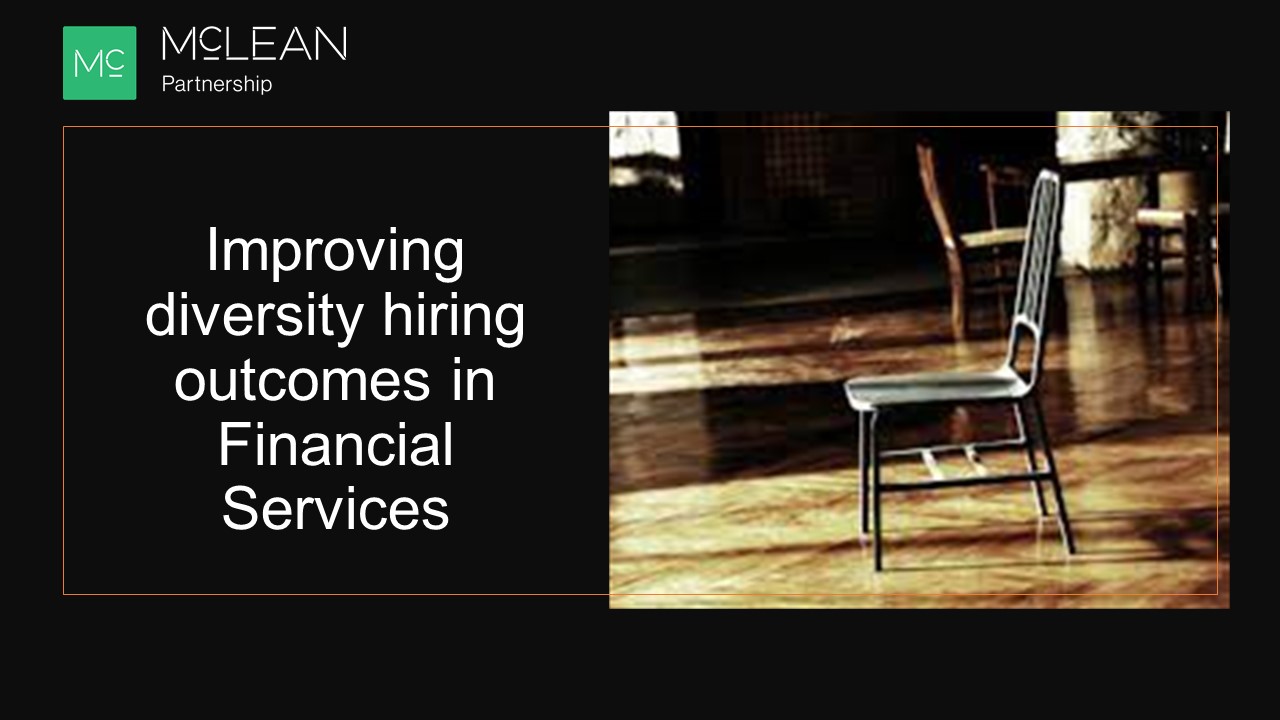Diversity in financial services is being held back by outdated hiring methods
Gender equality is moving in the right direction at UK investment banks and asset managers, it’s just happening at a slower rate than it should be.
Gender pay gap data, though imperfect, is a useful barometer for progress. Women working at UK investment banks earn about 56% of their male colleagues, according to preliminary numbers tallied by Bloomberg. The problem in many cases is due to the scarcity of women in senior positions, rather than conscious decisions to pay female employees less than their male counterparts.
That puts training, nurturing and smart hiring at the core of the industry’s equality push, yet we’re still seeing institutions using the same hiring techniques they’ve used for decades.
Here at McLean, we fill dozens of positions at global, UK-based institutions every year. Often companies have their own methods, depending on corporate culture, but there are some common pitfalls worth dwelling on. Correcting them using a few simple techniques could go a long way in improving diversity in an industry lagging on the key metrics.
Firstly, senior revenue generators still dominate the hiring process. These individuals generate the best results with clients, so their views naturally hold weight, but are they the person with the best managerial skills? Do they have the required interview training or technique? What about inclusive hiring training?
“Affinity bias” is well documented. We gravitate towards people that share our appearance, beliefs and background, so there are clear risks presented by allowing a white, male managing director to lead the process.
While researching for this piece I spoke with a partner at a top-tier management consultancy. The industry has a similar set of diversity challenges but the measures they have in place sets them on a course for a greater rate of progress over medium term. Like investment banks they have a base layer of requirements – very strong A level performance, degree educated, a demonstrated drive across non-academic subjects and so on, but from that point hiring processes tend to diverge.
Firstly, CVs are screened using a statistical model that adjusts scoring to remove opportunity and affinity bias. After the initial screen comes a numerical reasoning test, checking whether candidates process information and manipulate it to the required degree.
Next comes a series of case studies to check business skills, and crucially a psychometric test and a competency & behaviour assessment, something we rarely see in investment banking and asset management. This is arguably the most important phase. It slashes the potential for bias and raises the probability of smarter hires.
The management consultancy uses an internal panel of specially trained individuals for this phase and the make-up of the panel is key. These are trained staff at junior consultant and above, not solely partners and managing directors. They don’t receive the candidate’s CV and are coached in how to avoid questions that might reveal aspects of their background.
Instead, questions lead with phrases that include “give me an example of”, “how do you react if”, “when have you”. These are designed to test the Emotional Quotient – the ability to understand, perceive, use and manage emotions. In other words, it’s not the face you can put on for a two-hour interview, or the bravado with which you can discuss your client list, it’s how you can connect with people outside of the meeting room you’re currently sitting in.
The process acts as a buttress against bias and is far more effective in finding the better candidates, my source tells me. You can be a brilliant analyst and fly through the case studies interviews, for example, but the likelihood of in-house conflict rises without the softer skills and crucially, client relationships suffer. “People do business with people they like,” is an adage for a reason.
Finally, thereis a broad failure to consider how the process impacts the perceptions of the candidates themselves. It’s bonus season and the big investment banks are handing out cheques on a scale that we haven’t seen since the financial crisis. The war for talent is fierce, so the perception of top candidates in interviews is crucial.
This year, we’ve witnessed searches for seats on all male teams that were keen to bring diversity into the unit. In some cases that’s led to a male only interview process. In others a senior female manager has joined at a late stage. Hiring processes with no peer appropriate participants risk giving candidates a skewed view of team culture and can create negative perceptions of the wider company. In these cases we recommend ensuring a female team member joins an early stage interview – or if necessary a member from a neighbouring team. She will likely pick up on different behavioural criteria and will reassure that diversity is represented more broadly.
I’ve worked at The McLean Partnership for the past 13 years and I happen to work on a predominantly male team. Between us, we are often surprised by how differently we read people. This is particularly the case with female candidates. Our most significant diversity challenges come in searches in which we have a male hiring manager of an all-male team, talking with a male search consultant.
When we broaden out the team on our side and bring the opposite sex into the conversations, finer nuances emerge, particularly when discussing having children and the individual’s concerns over fit, diversity and team culture. The full picture becomes clearer when we work together.
None of the suggestions above place great demands on time or costs, but they require a recalibration of how interviews are approached and conducted. The immediate benefits are clear – greatly improved chances of finding the right candidates, with all the business benefits that entails. There is a deep body of research suggesting diverse teams lead to better outcomes in terms of profitability, but that is only part of the arguably more important goal of improving diversity within an industry that has been too slow to change.




